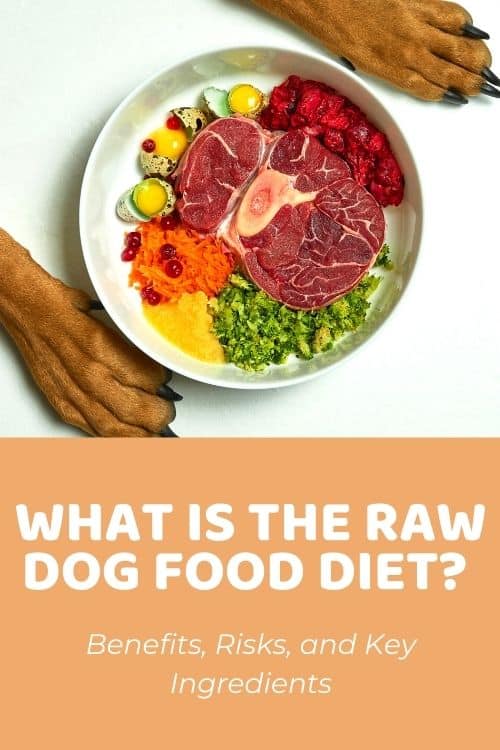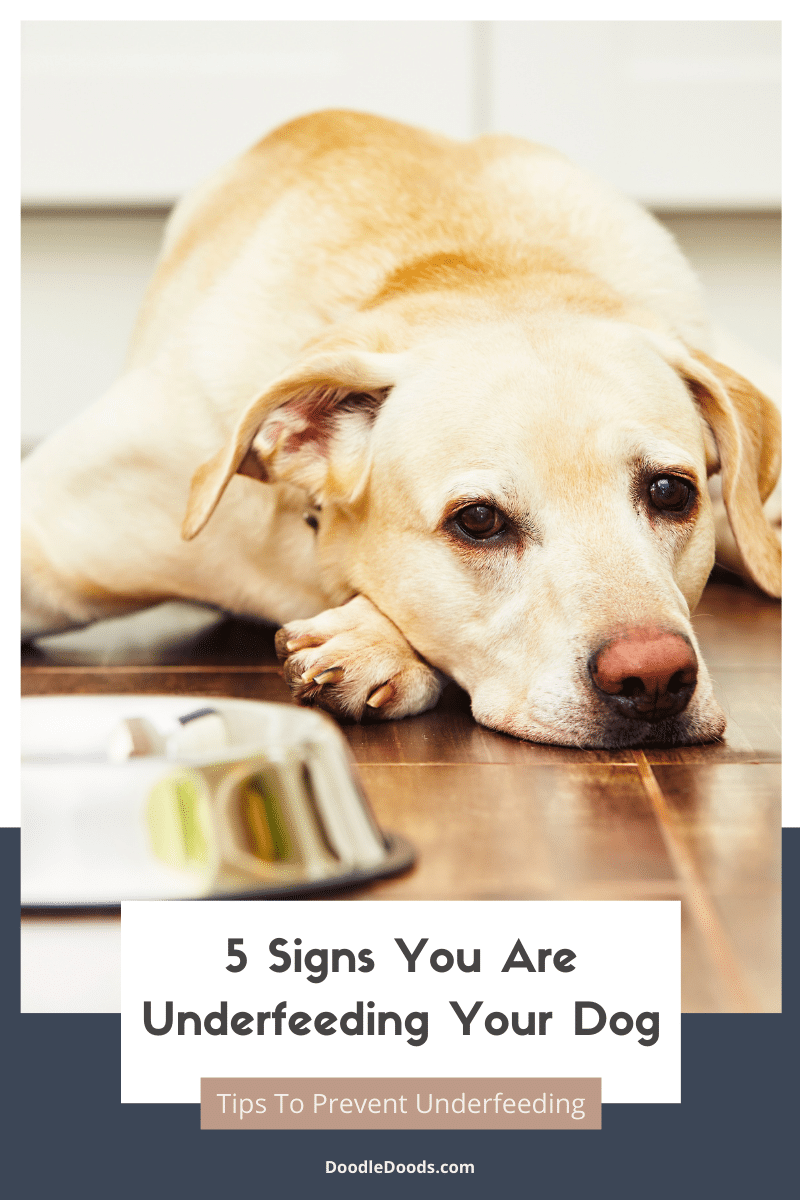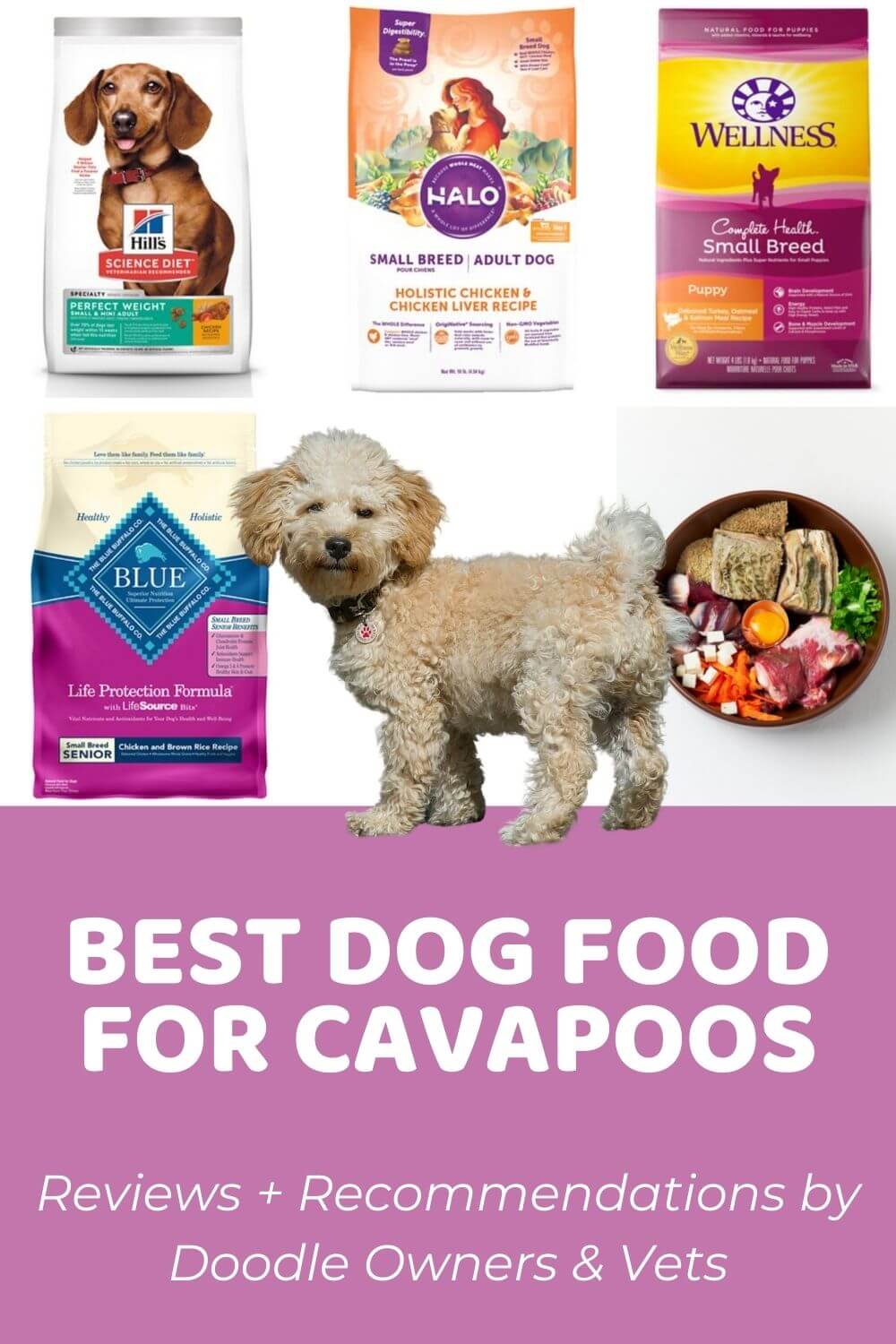Matipoos are generally happy, healthy dogs. Make sure to keep yours that way by serving up the right kind of food with the best blend of nutrients. Keep scrolling to see our best dog food for Maltipoos choices based on literally hundreds of pet parent reviews.
Our Top 6 Pup-Approved Foods for Maltipoos
The foods on this list are the very best of the best. Any one of them would be great for your Malti. If you have a little time, check out our detailed reviews of each of the product below:
-
Pick #1:
Halo Holistic Chicken & Chicken Liver Small Breed Dry Dog Food. Excellently nutritious with high percentages of protein and omega fatty acids, Halo’s food contains sustainably sourced ingredients and absolutely nothing artificial.
-
Pick #2:
Hill’s Science Diet Adult Small & Mini Perfect Weight Dry Dog Food. Low in calories but high in taste and crucial vitamins and minerals, Hill’s formula is excellent for plump pups who love their chow but are looking to lose a few lbs.
-
Pick #3:
Blue Buffalo Life Protection Formula Small Breed Senior Chicken & Brown Rice Recipe Dry Dog Food. A firm pet parent favorite, Blue Buffalo’s blend is rich in glucosamine, chondroitin sulfate, and other nutrients that support painful joints and overall canine aging.
-
Pick #4:
Purina Pro Plan Small Breed Adult Sensitive Skin & Stomach Formula Dry Dog Food. Perfect for pups with allergies, Purina’s super-premium food, fortified with probiotics and fiber, is designed to be healthy, nutritious, and incredibly easy to digest.
-
Pick #5:
Merrick Lil’ Plates Healthy Grains Real Lamb + Brown Rice Recipe Small Breed Adult Dry Dog Food. With super scrumptious lamb as the first ingredient, Merrick’s recipe, which contains ancient grains and helpful nutrients, is designed to tempt even the fussiest of pups.
-
Pick #6:
Diamond Naturals Small Breed Adult Chicken & Rice Formula Dry Dog Food. As well as high levels of lean, healthy protein, Diamond’s fab formula contains superfoods such as kale, blueberries, spinach, and papaya for an immune system boost.
-
Pick #7:
Wellness Small Breed Complete Health Puppy Turkey, Oatmeal & Salmon Meal Recipe Dry Dog Food. Featuring premium proteins and key nutrients such as calcium and vitamins A, C, and E, which all support effective development. Wellness’s formula is perfect for all small breed puppies.
Maltipoo Nutritional Needs: A Quick Overview
Maltipoos are relatively new but increasingly popular hybrid dogs. These charming, active pups combine all the best qualities of their parent breeds, the affectionate Maltese and the fun-loving Poodle.
Great for experienced and novice owners alike, these highly adaptable Doodles make perfect apartment pets. They are equally as good with children as with adults.
Looking for the best food for Doodle breeds – especially the newer ones – can be a little tricky as they’re not yet standardized. This means that we don’t really know all that much about them. However, most toy breeds have fairly consistent nutritional needs. Yet, these can vary by life stage and activity level. This is true of all dogs.
The best thing to do is select a food that is tailored to your dog’s specific needs. One formulated for small breeds will contain the best balance of nutrients, vitamins, and minerals for these dogs, and the kibble will be a suitable size for them. For puppies or seniors, opt for appropriate life stage foods. Younger dogs need plenty of energy and nutrients that will support their growth. Older dogs require fewer calories and added glucosamine and chondroitin sulfate for joint health.
While wet food may be the more popular choice as far as your dog is concerned, kibble is generally the better option nutritionally speaking. It also boasts additional benefits such as helping to keep teeth and gums clean and healthy. If your Malti is reluctant to give kibble a go, try mixing in some water or low sodium broth. If this doesn’t work, a diet that is 50/50 wet and dry food combined might be your only other option.
Maltipoo Health Issues and How Food Can Help
While dogs of a certain size might share common dietary requirements, health issues can be either size or breed-specific. These also need to be considered when picking out the perfect food for your pup.
As covered above, we don’t yet know much about Maltipoos as a separate breed, and the different generations add to the confusion. However, we can look to the parent dogs for some understanding of the conditions to which they may be susceptible.
Hypoglycemia
Small dogs such as Maltipoos can have issues with low sugar levels due to their metabolic rate, which, surprisingly, is significantly higher than in larger breeds. Symptoms of hypoglycemia are weakness, lethargy, muscle tremors, and in more extreme cases, seizures and death. Not only do small dogs need to be fed little and often, they also require calorie-dense food that satisfies their high energy needs.
Obesity
Obesity is a common problem among the country’s canines – especially for toy breeds who may not receive quite as much exercise as they need. Males sit somewhere between the incredibly active Poodle and the lapdog Maltese, so they have varying energy levels. If your dog starts piling on the pounds, a low-calorie food might be best.
Allergies
Like Poodles, Maltese are prone to food intolerance and hypersensitivity. Avoid foods that contain random ‘meat’ by-products, as well as fillers and artificial ingredients. If your pooch does suffer from allergies, recognizable by symptoms such as dry, itchy skin as well as more obvious poop problems, a sensitive blend or limited ingredient formula could help.
Eye Problems
Smaller breeds can also suffer issues with their eyes, such as retinal atrophy. Foods rich in beta carotene, vitamin E, vitamin C, and DHA boost eye health and support an assortment of other essential body functions. Look for kibble containing a wide range of fresh fruits and vegetables to ensure your pup receives these vital nutrients.
Joint Pain
While small breeds may be less susceptible to joint issues than larger dogs, it can still impact them – especially late in life. Omega fatty acids such as omega 3 and omega 6 not only provide relief from associated pain caused by arthritis but can also help to prevent joint degradation in younger dogs.
Best Food for Maltipoos: Buyer’s Guide
Ingredients lists can be incredibly confusing things. Luckily though, most popular dog food brands have broken things down to make it as easy as possible for you to know exactly what you are giving your dog. Keep an eye out for the following:
High-Quality Proteins
For dogs, animal proteins are the very best source of amino acids, the essential building blocks of life. These aid with muscle development, cell regeneration, and effective organ functioning, among other things. For this reason, the very first listed ingredient in any dog food you consider should be meat. Lean ones such as chicken, turkey, and fish are usually best for less active dogs.
Healthy Fats
While humans gain most of their energy from carbs, canines get theirs from fats. As is the case with proteins, animal products are the best source of these helpful fats. However, coconut oil and plant-based fats like olive and canola oil do provide some benefits. Fatty acids are also important for dogs, especially omega-3 and 6, which help with joint, skin, and coat health.
Canine-Compatible Carbs
Somewhere between carnivores and omnivores, dogs have inherited the ability to break down and make use of nutrients found in carbohydrates – just perhaps not to the extent that we have. Carbohydrates can also help keep your pup feeling fuller for longer, and fiber is excellent for supporting healthy digestion. Just avoid foods with too much of fillers like wheat and corn.
Beneficial Extras
Most foods these days come with added nutrients for supporting your pal at their particular life stage. Added calcium helps with bone development, glucosamine and chondroitin keep joints healthy. Antioxidants support the effective functioning of the immune system – staving off illness and disease. Probiotics are great for keeping the digestive system healthy and balanced.
Best Foods for Maltipoos: Reviews
Best for Regular Use
Whole meat from cage-free chickens and non-GMO fruits and veggies is combined with many healthful other ingredients in this super tasty small-breed blend. The Association of American Feed Control Officials recommend adult dogs receive at least 18% crude protein, but this excellent pick contains a whole 27%! So, not only is it great for your pooch, but they will likely love it too.
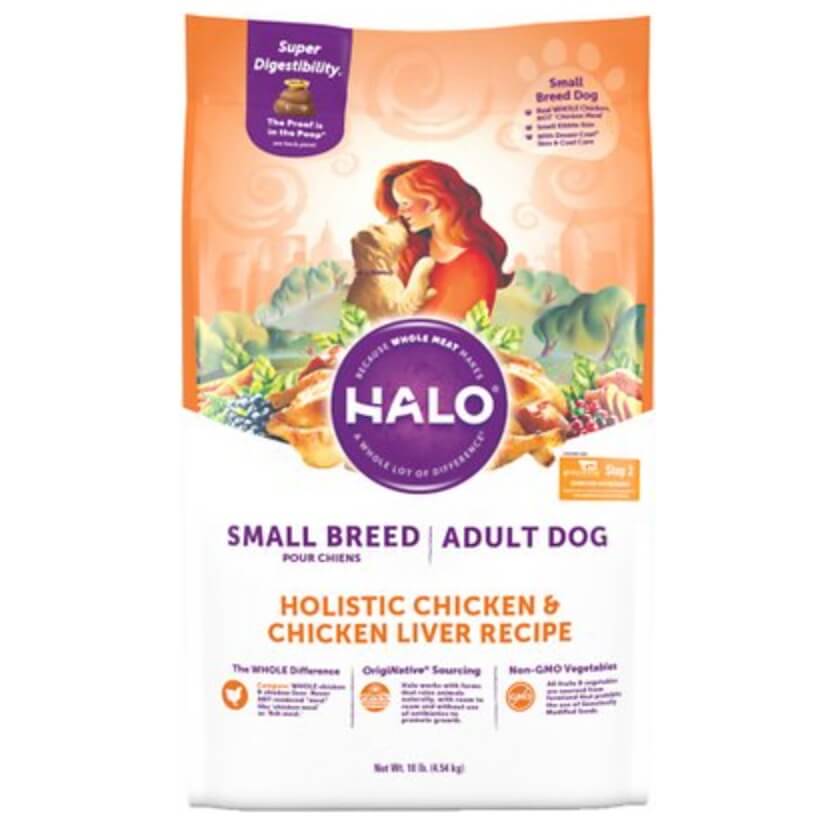
Most reviewers wholeheartedly approve of this food, commenting that it is a good size for smaller mouths and that it doesn’t smell. It also seems to do the trick for finicky eaters and sensitive stomachs alike. It comes highly recommended by both Poodle and Maltese owners. They rave about shiny coats and excellent overall health with this brand.
Pros
The cruelty-free food sources, the super healthy ingredients, the lack of meat by-products and fillers – what’s not to like?
Cons
This food is slightly higher in price than others on this list, but it is clearly premium quality.
Best for Weight Loss
Backed by decades of cutting-edge research, Hill’s Science Diet foods are recommended by veterinarians across the country for pups with weight issues. Even though it is much lower in calories than other types, the blend is nutritionally balanced for small breeds. It helps them maintain lean muscles while supporting healthy digestion and a robust immune system.

Most pet parents have found that their babies love the flavor of this fab food – not always a given with a diet blend. There also seems to be no sign of a drop in energy levels for pets eating this formula. The pellets are a good size and are easy for small dogs to chew and digest.
Pros
Any foods that vets recommend are good by us! What an excellent bonus that even picky eaters seem to like it.
Cons
No issues here!
Best for Older Dogs
Manufactured from top-quality chicken, whole grains, garden fruits, and veggies, Blue Buffalo’s foods also contain ‘LifeSource Bits.’ These are a precise blend of nutrients that have been enhanced with a Super 7 package of antioxidant-rich ingredients. This exceptional food will support your pooch’s bones, teeth, immune system, joints, muscles, energy levels, and more, well into their golden years.
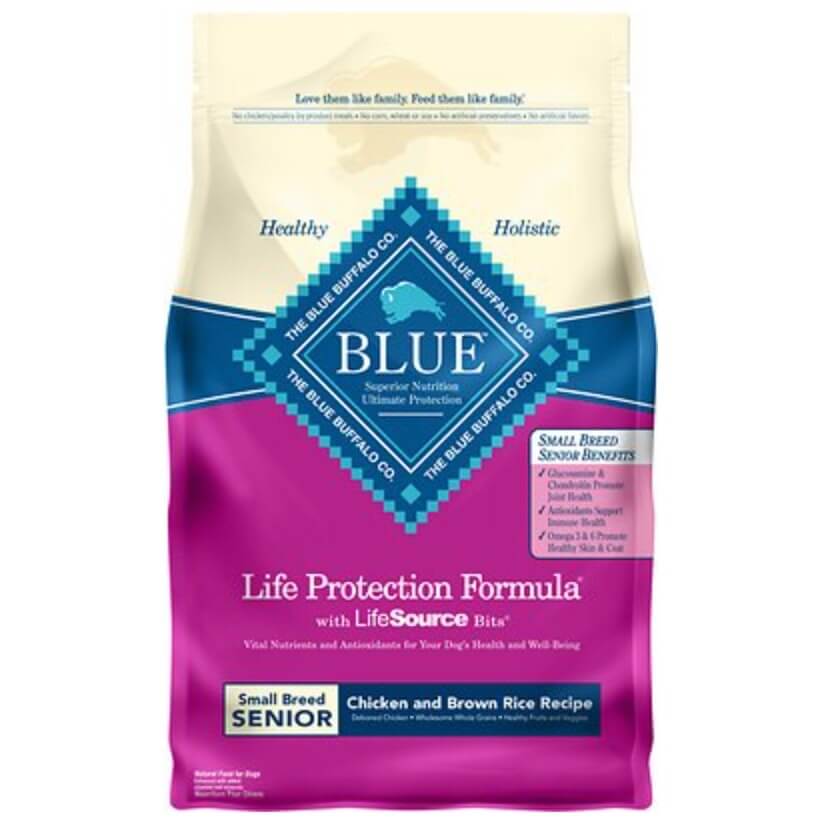
Overall, reviews are positive, with users being impressed with the healthful ingredients, the size of the kibble, and the effect this fab food had on their pets. Many were thrilled that it made their dogs more puppylike and playful and that mobility issues seemed to almost disappear. The nutrients are a good fit for seniors too, with reduced fat levels and overall calories.
Pros
Every ingredient in this expert blend works towards keeping dogs younger and healthier for longer.
Cons
Some pups aren’t big fans of the LifeSource Bits – maybe because they are plant rather than protein-based.
Best for Sensitive Souls
Super salmon is the top ingredient in this tasty kibble. It is rich and flavorful while still being kind to troubled tummies since it’s crafted without corn, wheat, soy, poultry by-products, or any other problematic fillers, additives, and allergens. Instead, it’s packed with essential vitamins and minerals (at least 23 of them!) that support health and wellbeing.
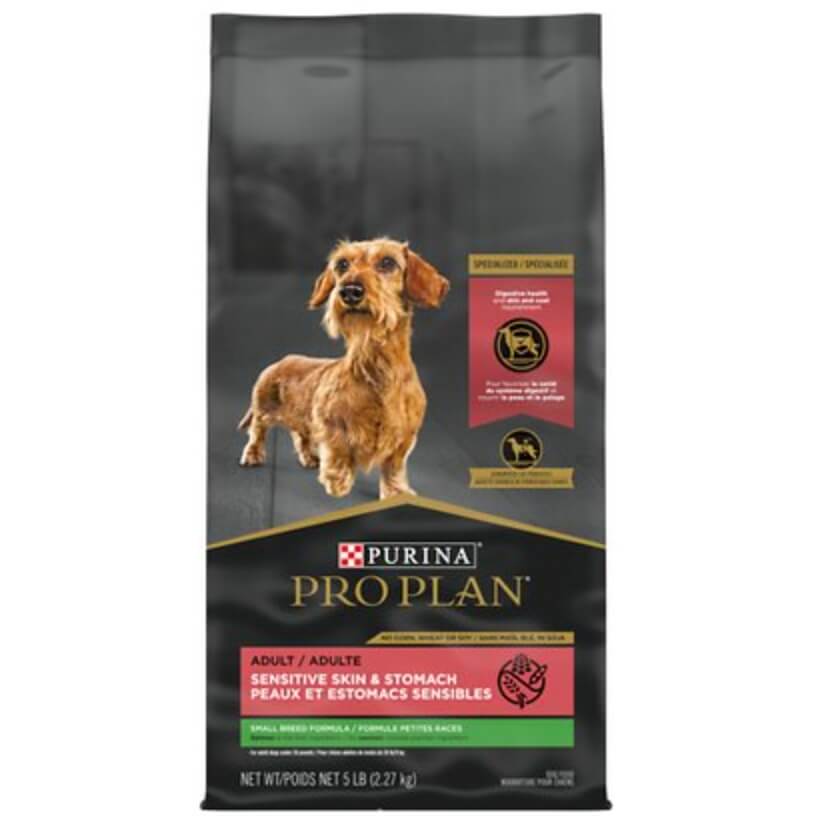
There are plenty of positive comments for this food too (naturally – otherwise it wouldn’t be on our list). Reviewers mention that this product worked for their dogs even when more expensive alternatives didn’t – which says a lot. The chicken-free formula is a massive benefit of this food. Those with sensitivities often struggle with chicken and chicken by-products.
Pros
Great for dogs with digestive issues, reduces issues with itchy skin. Pups seem to enjoy the taste.
Cons
This food is at the top end of the calorie scale, so you might have to reduce the amount you give your dog otherwise they could end up gaining weight.
Best for Picky Eaters
Formulated for maximum taste, Merrick’s offering contains all the health benefits of its predecessors on this list. This includes added probiotics and prebiotic fiber, a super blend of crucial vitamins and minerals, and a lack of fillers and allergens. While not specifically designed for seniors, it is also rich in elements such as glucosamine and chondroitin that reduce the chances of joint problems in later life.
With a single negative review (at the time of writing this), this product definitely seems to be a winner among dog owners. Most mention the high-quality of the ingredients – particularly the ‘REAL lamb’ and the fact that their dogs ‘took to it right away’ and ‘just gobbled it down’. They also loved the breakdown of ingredients on the bag.
Pros
This food features a mouthwatering list of ingredients that sound tempting even to us – if we were in the habit of eating dog food.
Cons
The negative comment was about the cost of the food. It is on the higher end of the spectrum, but you get what you pay for.
Best for Recovering Pups
With chicken, rice, and an assortment of awesome superfoods, Diamond’s kibble seems tailor-made for pups in need of a bit of a health lift. Not only is there an abundance of beneficial vitamins and minerals, probiotics and antioxidants, and phytonutrients for ultimate wellbeing, but the formula is manufactured in the USA using local and trusted ingredients for holistic nutrition.
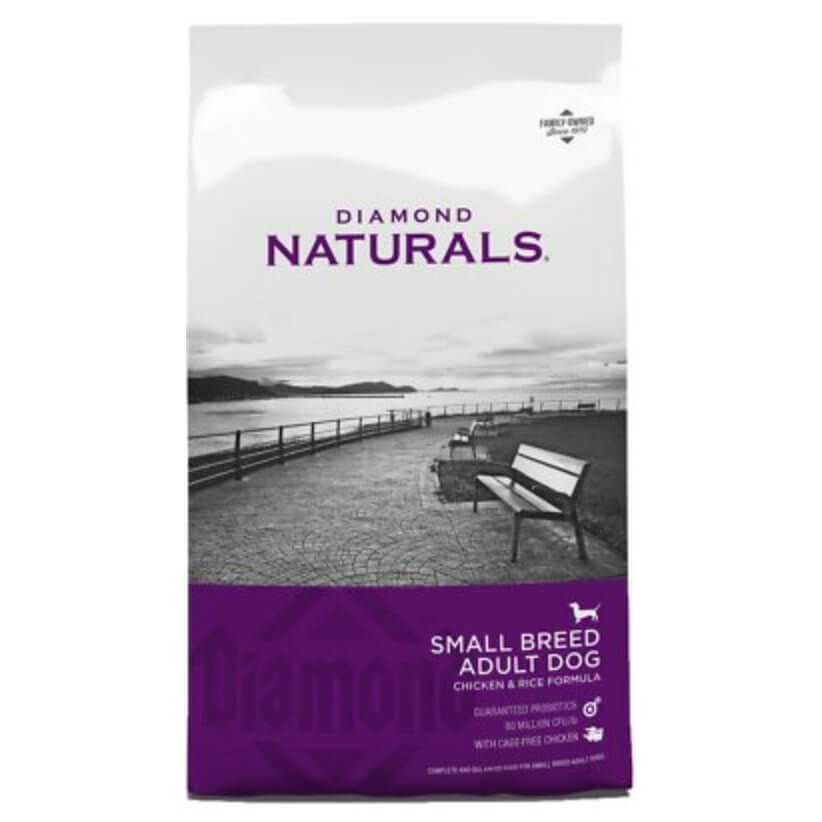
‘Good value and high quality’ seems to be the general consensus on this kibble, along with the fact that it’s suitable even for more sensitive pups and picky eaters. People also comment on the noticeable benefits of the food on their pet’s skin and coat, and it’s small enough even for the tiniest of teeth to deal with. It’s also vet-approved, so we know it’s good.
Pros
This product is surprisingly good value for money considering the quality of the ingredients.
Cons
No issues beyond very few dogs seeming not to like it.
Best for Puppies
Crafted specifically for puppies for whole-body health, this dry food contains everything necessary to give your fur-baby the very best start in life. The all-natural ingredients are fortified with omega fatty acids—including DHA—antioxidants, essential vitamins, and probiotics. With absolutely no meat by-products, fillers, or artificial preservatives, you can be sure your puppy is getting only good stuff.
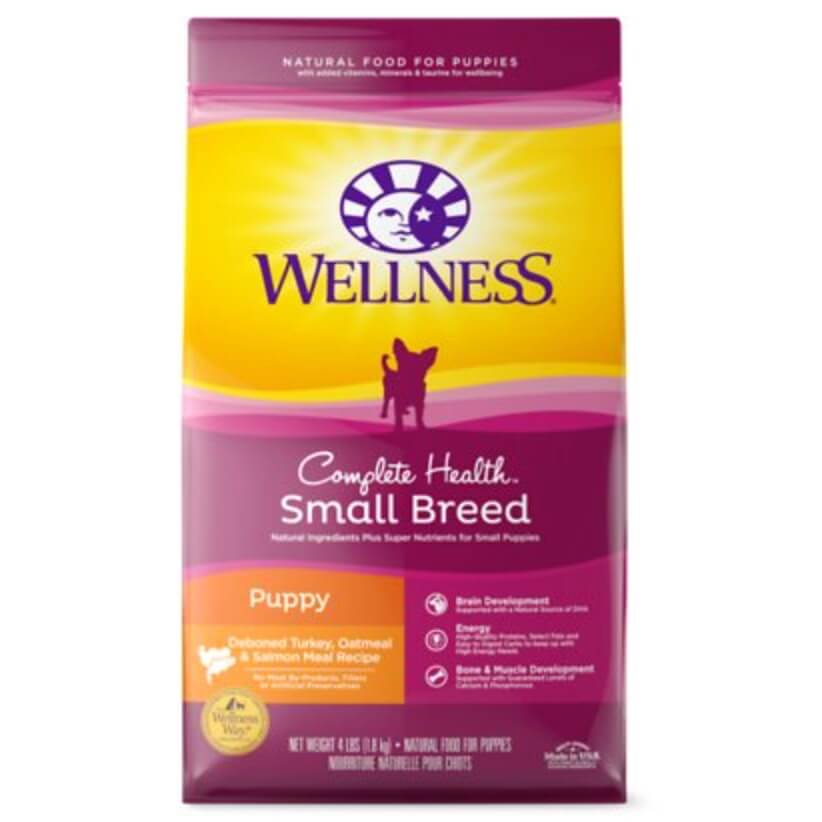
Another vet-recommended brand, Wellness is prized among pet parents for its excellent nutrient content and tasty flavors that go down well with most puppies. Even breeders comment that they see noticeable improvements in the appearance of their puppies from the get-go.
Pros
The excellent combination of nutrients is perfect for growing pups.
Cons
Some reviewers comment that the kibble is a little bigger than expected and tough for their young ones to chew without softening.
The Homemade Food Option
Some owners may choose to make their dog’s food from scratch. The most significant benefit of this is you know exactly what’s going into the food. However, finding the right balance of nutrients for your pup can be a little tricky at first.
The primary ingredient should be protein; fish and lean meat cuts are best. Beyond that, you will also need to include vegetables, fruits, and healthy grains. The best thing to do is find recipes for small breeds devised by experts.
Experts over at the American Kennel Club have compiled a list of does and don’ts when it comes to making your own dog food.
Ingredients to Avoid in Maltipoo Food
When checking food packets, a good rule of thumb is to avoid ingredients with long names that you don’t know what they are. Here are a few to definitely bypass:
- Melamine – Added to foods to boost perceived protein content, this chemical compound contains toxic nitrogen that could cause kidney failure.
- BHA, BHT, and Ethoxyquin – Used to extend the shelf life of certain foods, these artificial preservatives can be harmful for dogs with long-term exposure or ingestion.
- Food Dyes and Corn Syrup – Often included to make the kibble more visually appealing to people and taste sweeter, these both should be avoided.
- MSG – Monosodium Glutamate was a popular flavor enhancer in the past. These days most people know it’s bad for them – the same is true for their pets.
Grain vs Grain-Free
Many brands currently offer grain-free options for pups with allergies or sensitive stomachs. However, questions have been raised about the safety of grain-free diets for dogs, with an increase in instances of heart conditions in breeds not prone to these types of issues. At present, it seems that no conclusive links have been established between the two.
For more on this check out our dedicated blog post Is Grain-Free Good for Dogs? The Long Debate
Maltipoo Feeding Guide
Maltipoos, like other small dogs, need to be fed little and often. Three or four meals a day are recommended, and healthy snacks can also help keep your pup ticking over in between. If you are out at work during these times, then a treat dispenser is a handy thing to invest in.
Portion sizes are based on weight. The number of calories that your pooch requires varies depending on their age and status (a pregnant or nursing mother will need more than usual). Puppies need around 55 calories per pound of body weight, and adult dogs should have 40 calories per pound of body weight.
For kibble, this translates as:
- 2 to 4 lbs. 1/4 to 1/3 cups per day.
- 5 to 8 lbs. 1/2 to 3/4 cups per day.
- 9 to 12 lbs. = 3/4 to 1 cup per day.
- 13 to 16 lbs. = 1 to 1 and 1/4 cups per day.
So, the average 10 lb Maltipoo needs around 400 calories per day, and this is the same for both males and females. If your pooch is on the active side, they may need slightly more; if they are a homebody, slightly less. However, you will often find that individual manufacturers provide their own guidelines based on their specific food. These are generally pretty accurate.

Maltipoo Nutrition: Frequently Asked Questions
What is the best food to feed a Maltipoo?
The best food to feed your Maltipoo is one that is aimed at their particular size and life stage. Small/toy breed formulas are best, and also consider their age and anything else that may impact their nutritional needs, such as whether they are very active/sedentary or pregnant/nursing.
What fruits can Maltipoos eat?
Malties can eat many different types of fruits, including apples, bananas, blueberries, and oranges. However, there are a few that are toxic for canines, such as avocados, cherries, grapes, and raisins. For a more complete list, check out this article by the American Kennel Club.
Are Maltipoos picky eaters?
Maltipoos can indeed be picky eaters like their Maltese and Poodle parents. Introduce them to new foods gradually by mixing them in with their old one. Add healthy kibble toppers for particularly fussy pooches to get them accustomed to eating this type of food.
A big part of taking care of your canine friend is finding the very best food to keep them active and healthy throughout their life. We are lucky today that there are so many high-quality brands producing dog kibble that have been developed specifically for dogs of different sizes. When it comes to picking out the perfect one for your Maltipoo, you can’t go wrong with any from our list.
The information on this page is for informational purposes only. It is not intended to be a substitute for qualified professional veterinary advice, diagnosis, or treatment. Always seek the advice of your veterinarian or other qualified animal health provider with any questions you may have.



